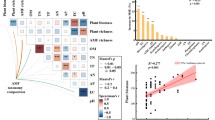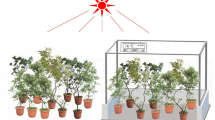Abstract
Aboveground production and tissue element composition of Spartina alterniflora were compared in bareier island marshes of different age off the Eastern Shore of Virginia. The marshes were also characterized by physical and chemical parameters of the substrate. The results suggest that sediment nutrient stock do not directly control the spatial pattern of element content or production of S. alterniflora between these marshes. Elevated salinity likely limits the nitrogen uptake capability of S. alterniflora in the high marsh, which, in turn, controls leaf tissue nitrogen content of plants within individual sites. Low substrate redox potential may control the spatial pattern of nitrogen uptake between the different-age marsh sites, loading to more favorable growing conditions at the low stations of the young marsh sites where values of tissue nitrogen and production are highest. Tissue phosphorus did not differ between, or within the marsh sites. The result of a fertilization experiment suggest that nitrogen, and not phosphorus, is the primary limiting nutrient in this sytem. This indicates that nutrient limitation and other stresses work in conjunction to control tissue element content and macrophyte production at these marsh sites. Spatial variability of factors that control leaf tissue nitrogen and production is likely related to topography and grain size of an individual marsh, which is a function of marsh age. Most studies in different-age marshes have compared transplanted marshes to older, natural marshes. This work is one of few studies comparing developing and mature natural, marshes on barrier islands.
Similar content being viewed by others
Literature Cited
Abacus Concepts. 1989. Super ANOVA. Abacus Concepts, Inc., Berkeley, California.
Agosta, K. 1985. The effect of tidally induced changes in the creekbank water table on porewater chemistry. Estuarine Coastal and Shelf Science 21:389–400.
Atkinson, M. J. and S. V. Smith. 1983. C:N:P ratios, of benthic marine plants. Limnology and Oceanography 28:568–574.
Bradley, P. M. and J. T. Morris. 1990. Influence of oxygen and sulfide concentration on nitrogen uptake kinetics in Spartina alterniflora. Ecology 71:282–287.
Bradley, P. M. and J. T. Morris. 1991. The influence of salinity on the kinetics of NH4+-uptake in Spartina alterniflora. Oecologia 85:375–380.
Broome, S. W., W. W. Woodhouse, and E. D. Seneca. 1975. The relationship of mineral nutrients to growth of Spartina alterniflora in North Carolina: I. Nutrient status plants and soils in natural stands. II. The effects of N, P, and Fe fertilizers. Soil Science Society of America Proceedings 39:295–307.
Brower, J. E. and J. H. Zar. 1984. Field and Laboratory Methods for General Ecology. 2nd ed. Wm. C. Brown, Inc., Dubuque, Iowa. 226 p.
Caton, R. D., Jr. 1977. Reference electrodes, p. 112–119. In G. W. Ewing (ed.), Topics in Chemical Instrumentation, Vol. 2. American Chemical Society, Washington, D.C.
Cavalieri, A. J. and A. H. C. Huang. 1981. Accumulation of proline and glycinebetaine in Spartina alterniflora Loisel. in response to NaCl and nitrogen in the marsh. Oecologia 49: 224–228.
Chalmers, A. G. 1979. The effects of fertilization on nitrogen distribution in a spartina, alterniflora salt marsh. Estuarine and Coastal Marine Science 8:327–337.
Chambers, R. M. and W. E. Odum. 1990. Porewater oxidation, dissolved phosphate, and the iron curtain: Iron-phosphorus relations in tidal freshwater marshes Biogeochemistry 10:37–52.
Chambers, R. M. and J. W. Fourqurean. 1991. Alternative criteria for assessing nutrient limitation of a wetland macrophyte (Peltandra virginica (L.) Kunth). Aquatic Botany 40: 305–320.
Craft, C. B., S. W. Broome, and E. D. Seneca. 1988. Nitrogen, phosphorus, and carbon pools in natural and transplaned marsh soils. Estuaries 11:272–280.
DeLaune, R. D. and S. R. Pezeshki. 1988. Relationships of mineral nutrients to growth of Spartina alterniflora in Louisiana salt marshes. Northeast Gulf Science 10:55–60.
Frey, R. W. and P. B. Basan. 1978. Coastal salt marshes, p. 101–159. In R. A. Davis, Jr. (ed.), Coastal Sedimentary Environments. Springer-Verlag, New York.
Gallagher, J. L. 1975. Effect of an ammonium nitrate pulse on the growth and elemental composition of natural stands of Spartina alterniflora and Juncus roemerianus. American Journal of Botany 62:644–648.
Gerloff, G. C. and P. H. Kromholtz. 1966. Tissue analysis as a measure of nutrient availability for the growth of angiosperm aquatic plants. Limnology and Oceanography 11:529–537.
Godfrey, P. J. and M. M. Godfrey. 1976. Barrier island ecology of Cape Lookout National Seashore and vicinity, North Carolina. National Park Service Monograph Series No. 9, Washington, D.C. 160 p.
Good, R. E., N. F. Good, and B. F. Frasco. 1982. A review of primary production and decomposition of the belowground components, p. 139–157. In V. S. Kennedy (ed.), Estuarine Comparisons. Academic Press, New York.
Haines, B. L. and E. L. Dunn. 1976. Growth and resource allocation responses of Spartina alterniflora Loisel to three levels of NH4-N, Fe, and NaCl in solution culture. Botanical Gazette 137:224–230.
Haines, E., A. Chalmers, R. Hanson, and B. Sherr. 1977. Nitrogen pools and fluxes in a Georgia salt marsh, p. 241–254. In M. Wiley (ed.), Estuarine Processss, Vol. 2. Academic Press, New York.
Hemond, H. F. and J. L. Fifield. 1982. Subsurface flow in salt marsh peat: A model and field study. Limnology and Oceanography 27:126–136.
Howarth, R. W. 1988. Nutrient limitation of net primary production in marine ecosystems. Annual Review of Ecology 19: 89–110.
Howes, B. L., R. W. Howarth, J. M. Teal, and I. Valiela. 1981. Oxidation-reduction potentials in a salt marsh: Spatial patterns and interactions with primary production. Limnology and Oceanography 26:350–360.
Koch, M. S., I. A. Mendelssohn, and K. L. McKee. 1990. Mechanism for the hydrogen sulfide-induced growth limitation in wetland macrophytes. Limnology and Oceanography 35: 399–408.
Langis, R., M. Zalejko, and J. B. Zedler. 1991. Nitrogen assessments in a constructed and a natural salt marsh of San Diego Bay. Ecological Applications 1:40–51.
Lindau, C. W. and L. R. Hossner. 1981. Substrate characterization of an experimental marsh and three natural marshes. Soil Science Society of America Journal 45:1171–1176.
Mendelssohn, I. A. 1979a. Nitrogen metabolism in the height forms of Spartina, alterniflora in North Carolina. Ecology 60: 574–584.
Mendelssohn, I. A. 1979b. The influence of nitrogen, level, form, and application method on the growth response of Spartina alterniflora in North Carolina. Estuaries 2:106–112.
Mendelssohn, I. A., K. L. McKee, and W. H. Patrick, Jr. 1981. Oxygen deficiency in Spartina alterniflora roots: Metabolic adaptation to anoxia. Science 214: 439–441.
Mitsch, W. J. and J. G. Gosselink. 1986. Wetlands. Van Nostrand Reinhold, New York, 539 p.
Morris, J. T. 1982. A model of growth responses by Spartina alterniflora to nitrogen limitation. Journal of Ecology 70:25–42.
Morris, J. T. 1984. Effects of oxygen and salinity on ammonium uptake by Spartina, alterniflora Loisel. and Spartina patens (Aiton). Journal of Experimental Marine Biology and Ecology 78: 87–98.
Morris, J. T. 1988. Pathways and controls of the carbon cycle in salt marshes, p. 497–510. In D. D. Hook et al. (eds.), The Ecology and Management of Wetlands, Vol. 1: Ecology of Wetlands, Croom Helm, London.
Morris, J. T. and B. Haskin. 1990. A five-year record of aerial primary production and stand characteristics of Spartina alterniflora. Ecology 71:2209–2217.
Moy, L. D. and L. A. Levin. 1991. Are Spartina marshes a replaceable resource? A functional approach to evaluation of marsh creation efforts. Estuaries 14:1–16.
Nestler, J. 1977. Interstitial salinity as a cause of ecophenic variation in Spartina alterniflora. Estuarine and Coastal Marine Science 5:707–714.
Noggle, G. R. and G. J. Fritz. 1983. Introductory Plant Physiology, 2nd Ed. Prentice-Hall, Inc., Englewood Cliffs, New Jersey, 627 p.
Nuttle, W. K. and H. F. Hemond. 1988. Salt marsh hydrology: Implications for biogeochemical fluxes to the atmosphere and estuaries. Global Biogeochemical Cycles 2:91–114.
Ornes, W. H. and D. I. Kaplan. 1989. Macronutrient status of tall and short forms of Spartina, alterniflora in a South Carolina marsh. Marine Ecology Progress Series 55:63–72.
Osgood, D. T. and J. C. Zieman. 1993. Spatial and temporal patterns of substrate physicochemical parameters in different-aged barrier island marshes. Estuarine, Coastal and Shelf Science 37:421–436.
Parsons, T. R., Y. Maita, and C. M. Lalli. 1984. A Manual of Chemical and Biological Methods for Seawater Analysis. Pergamon Press, Oxford, 173 p.
Patrick, W. H., Jr. and R. D. DeLaune. 1976. Nitrogen and phosphorus utilization by Spartina alterniflora in a salt marsh in Barataria Bay, Louisiana. Estuarine and Coastal Marine Science 4:59–64.
Patrick, W. H., Jr. and R. D. DeLaune. 1977. Chemical and biological redox systems affecting nutrient availability in the coastal wetlands. Geoscience and Man 19:131–137.
Redfield, A. C. 1958. The biological control of chemical factors in the environment. American Scientist 46:205–222.
Shaver, G.R. and J. M. Melillo. 1984. Nutrient budgets, of marsh plants: Efficiency concepts and relation to availability. Ecology 65:1491–1510.
Sullivan, M. J. and F. C. Daiber. 1974. Response in production of cord grass, Spartina alterniflora, to inorganic nitrogen and phosphorus fertilizer. Chesapeake Science 17:121–123.
Valiela, I. and J. M. Teal. 1974. Nutrient limitation in salt marsh vegetation, p. 547–565. In R. J. Reimold and W. H. Queen (eds.), Ecology of Halophytes. Academic Press, New York.
Author information
Authors and Affiliations
Rights and permissions
About this article
Cite this article
Osgood, D.T., Zieman, J.C. Factors controlling aboveground Spartina alterniflora (Smooth cordgrass) tissue element composition and production in different-age barrier island marshes. Estuaries 16, 815–826 (1993). https://doi.org/10.2307/1352440
Received:
Accepted:
Issue Date:
DOI: https://doi.org/10.2307/1352440




